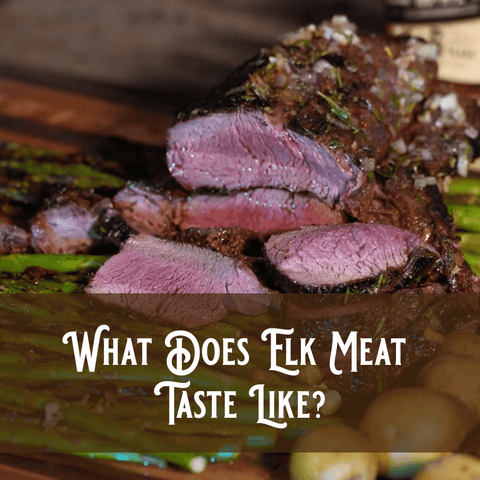Elk steak is renowned for being lean and flavorful. But while its low fat content is one of the reasons that elk is healthier than beef, it’s also why you’ll need to cook it with care and consideration to retain its moisture and tenderness.
Whether you choose to grill, sear, braise, or roast your elk meat, we have you covered. In this post, our team is sharing everything you need to know to create a memorable, delicious dining experience.

The Basics of Cooking Elk Meat
To get the full depth of flavor without sacrificing the natural juices and tenderness, we recommend cooking elk hot and fast or low and slow. Because it’s so lean, it’s best enjoyed rare to medium-rare. When first trying elk, lightly season it with just a bit of salt and pepper. This will allow you to experience the natural flavor of the meat.
How to Cook Elk Steak: Sear and Reverse Sear Methods
The key to cooking elk steaks is to opt for a quick sear over high heat. This will create a mouthwatering crust while keeping the interior moist. Here’s our favorite approach:
- Lightly season your elk steaks.
- Get your skillet nice and hot and then sear the steaks for a few minutes on each side.
- Remove the elk from the pan when its internal temperature reaches 120-125 degrees Fahrenheit, ensuring a perfect balance of texture and flavor.
- Let the meat rest for at least 5 minutes to allow the juices to redistribute, which will enhance the overall taste.
For an elk roast recipe, such as a French Rack or elk tenderloin, the "reverse sear" method provides consistent results.
- Preheat your oven to 225 degrees Fahrenheit.
- Place the seasoned roast on a center rack.
- Cook the elk until the thickest part of the roast reaches 120 degrees, which is rare.
- Put your oven on broil, generally 450 degrees, to deliver a final blast of heat. Turn the roast as necessary until the desired browning is achieved. This provides a beautifully caramelized exterior.
- Remove the roast from the oven and let it rest for 5-10 minutes.
This process results in a tender, flavorful roast worthy of any special occasion.

“Low and Slow” Cooking
For those who prefer their meat well done, techniques like braising or slow cooking won’t dry the elk out. These methods involve cooking elk at low temperatures over extended periods, often with liquid, to break down tough fibers and infuse the meat with rich, savory flavors.
The exact process will depend on the cut of meat and the specific technique you decide to use. Try one of our recipes that involves braising or slow cooking, such as:
- Elk Bourguignon
- Beer-Braised Elk Short Ribs
- Ground Elk Burger Soup
- Smoked and Braised Elk Chuck Roast Birria
- Dark Beer Braised Elk Bratwurst and Onions
- Elk Stew in Red Wine
These are all a great starting point for getting that fall-of-the-bone tenderness.

Seasoning Elk Meat
As we said, a simple seasoning of salt and pepper allows the meat’s flavor to shine. But if you’re looking to add an extra layer of complexity, elk pairs well with warm, earthy flavors like cinnamon, cloves and allspice. Incorporating these spices into a dry rub or marinade will give the meat depth.
A rub composed of herbs, such as rosemary, thyme and garlic is also a winner. This aromatic blend brings out the earthy undertones of elk while imparting a delightful aroma.
For roasts, try a savory herb crust made with a mixture of breadcrumbs, garlic and fresh herbs like parsley and sage. This adds tons of flavor and texture.
Don’t Forget the Sauces
When it comes to sauces, the possibilities are endless. These are some classic options:
- A red wine reduction complements elk beautifully. For a rich, velvety sauce, simmer red wine with shallots, garlic, and herbs until it thickens.
- A mushroom sauce made with a variety of wild mushrooms adds depth and umami notes, enhancing the overall dish.
- Berry sauces make a fantastic accompaniment to elk as well, adding a touch of sweetness and tartness.
- Cranberry sauce, enhanced with orange zest, cinnamon, and a splash of red wine, provides a sweet-tart contrast.
- Blueberry sauce with balsamic vinegar, shallots, and honey creates a balanced profile.
- Blackberry sauce, combined with red wine, rosemary, and a pinch of sugar, provides a robust flavor.
- Lingonberry sauce, popular in Scandinavian cuisine, cuts through the richness with its tartness.
- Tart cherry sauce, cooked with red wine, balsamic vinegar, and thyme, levels up the flavor and presentation.
- Add a hint of acidity and depth to the meat with a tangy mustard glaze that counterbalances the richness.

What to Serve With Elk
Pairing elk meat with complementary flavors brings out the best in the meat. When customers visit our Jackson Hole butcher shop, we recommend:
- Roasted root vegetables like carrots, potatoes, and parsnips enhance the earthy notes of elk.
- Whole grains such as wild rice and quinoa are hearty enough to stand up to the meat.
- A crisp salad with a tangy vinaigrette adds a refreshing contrast, balancing the richness of the meat. (We have an excellent elk recipe that includes a bright, fresh spinach salad here)

What Wine Pairs Well With Elk Meat?
Consider serving a full-bodied red wine like Cabernet Sauvignon or Malbec, whose robust flavors complement the depth of elk meat.
The Bottom Line
Cooking elk meat hot and fast to medium-rare doneness or low and slow maximizes the flavor and texture while retaining moisture. The key to creating a memorable dish is pairing elk with complementary spices, sauces, and accompaniments to allow the natural taste of the native game meat to take center stage.
Browse Our Recipes with Elk Steak and Cooking Tips
If you need some more inspiration check out our full collection of elk meat and elk steak recipes here. Happy cooking!


